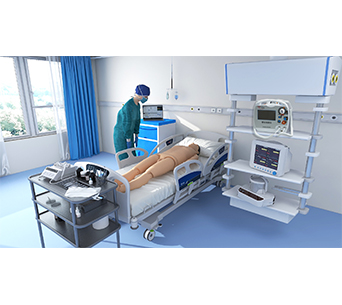■ The simulator is a comprehensive emergency simulation human, with a realistic hand feel, flexible joints, accurate anatomical landmarks, and easy operation and positioning.
■ Teachers can rate based on feedback from operation logs or student operation situations.
■ The pupil has the function of reflecting light and can reflect non synchronously to both eyes. There are three reflection modes: normal, slow, and no light reflection.
■ Palpable carotid artery pulsation, automatic recording and examination of the carotid artery.
■ There are three feasible methods to open the airway: lifting the chin, neck, and jaw with both hands.
■ Simulator can engage in autonomous breathing.
■ True pressing depth; Can provide real-time feedback on the quality of cardiopulmonary resuscitation, including compression depth, compression frequency, compression position information, whether compression rebound is complete, ventilation tidal volume, ventilation frequency, etc.
■ Can perform thoracic puncture, tibial bone marrow puncture practice, and cricoid puncture.

■ The right hand can be used for intravenous injection and blood collection. The puncture is correct and there is a clear sense of emptiness, and there is a phenomenon of blood return. The left hand can be used for blood pressure measurement practice.
■ Can practice multiple basic nursing operations, including oral care, removal of respiratory foreign bodies, sputum suction, oxygen therapy, nasal feeding, intravenous injection, intramuscular injection, subcutaneous injection, bathing, changing clothes, catheterization, enema, turning over, cold and hot therapy, external genital scrubbing, external genital wet and hot compress, fistula opening care, nebulized inhalation therapy, and more.
■ The system has two control modes
* Single item mode: The mentor can accurately control each reaction of the simulator on site, and can practice various single items such as CPR, defibrillation, tracheal intubation, etc.
* Case mode: With a case editing platform, operators can freely develop cases, and all changes in simulator can be pre designed. When designing, it is convenient to select the preset modules for patients to undergo physiological and pathological reactions to drugs and treatments, and the time and process are controllable.
■ Simulated defibrillator
* Able to practice automatic external defibrillation and automatically switch to normal sinus electrocardiogram after correct operation.
* Extracorporeal pacing can be performed, and the electrocardiogram automatically changes accordingly after each pacing.
* Can practice synchronous/asynchronous simulated defibrillation operations, defibrillation energy and frequency can be freely set, and there are prompts for correct defibrillation. The electrocardiogram changes and displays the defibrillation waveform during each defibrillation; After proper defibrillation, the system automatically responds and returns to a normal sinus electrocardiogram. If not treated correctly, a death electrocardiogram is displayed.
■ Simulated monitor
* Simulate the appearance of a real bedside monitor, with mechanical buttons and knob buttons to set the alarm settings for upper and lower limits of parameters such as heart rate, blood pressure, and blood oxygen.
* The system comes with dozens of types of electrocardiogram cases, which can be used in conjunction with multi parameter analog electrocardiogram monitors to achieve analog electrocardiogram monitoring.
■ Blood circulation simulator
* Blood flow velocity, circulation type, pulse frequency, and pulse intensity can all be adjusted.
* Equipped with LCD display screen, which can display pulse frequency, pulse intensity, etc.
■ Trauma module
* Equipped with a trauma module that includes various common traumas, trainees are trained to identify and handle wounds correctly in emergency situations.
* Can practice common techniques for first aid on-site, such as hemostasis, cleaning, disinfection, bandaging, fixation, and handling.
* Can create a realistic environment for massive bleeding, with adjustable blood flow rate.










